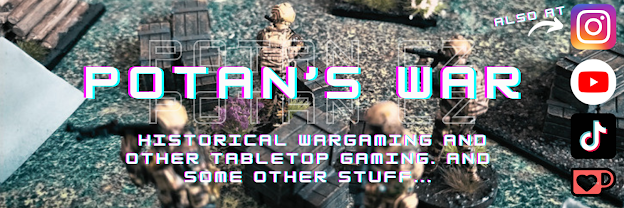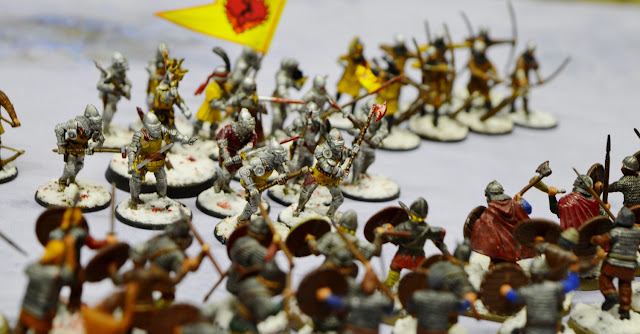Saga is a historical wargaming game for two or more players that focuses on battles in medieval, ancient, and even fantasy worlds. The game allows players to take on the role of commanders in larger skirmishes, primarily with 28mm figures. The game was first launched back in 2011 and originally focused purely on the dark medieval Viking Age, hence its name - Saga, a Norse epic about the heroic deeds of fearless warriors, which players also tried to do on the tabletop.
An expansion on the Crusades and the fall of Rome was eventually released, whereupon the game got a second edition in 2018 (which now gets a reprint for Christmas 2022, complete with new FAQs and errata) and a bunch of rulebooks for each period since. For the second edition of Saga, the game's publisher Studio Tomahawk has switched to the model it follows for its other main game, Muskets and Tomahawks, which is that it publishes "generic rulebooks" that describe the basic mechanics of the game (i.e. how to move, fight, shoot, etc.) without rules for armies, and then publishes books with rules for units.
This system has its advantages and disadvantages. The biggest advantage is that you only learn one set of custom rules and then you can add books for the periods you play and you can play several armies from different periods on one basic rulebook, because the mechanics are the same everywhere and only the rules for each army change. Which is great for people who have a large collection of figures and don't have to learn new rules for each period and one system takes care of it all.
 |
| This is what a complete warband looks like in the normal game. | source: konrad.kala |
The disadvantage, of course, is that in theory the basic rules are vaguely generic, so that they can be grafted onto more than 1,500 years of military history. What saves it are the specific army books and the fact that, at its core, Saga is not a "historical simulation of medieval warfare" but the telling of a story, the saga of a hero leading his soldiers into battle. Just as 300: The Battle of Thermopylae is a film adaptation and retelling of a comic book from the perspective of a Greek narrator, Saga is a game retelling of a similar story.
Saga's gameplay style and mechanics are adapted to this. A regular soldier has 1 attack, but the army commander has 8 because it's a story about him. Granted, his squad also has a stake in the story, but every heroic narrative has a main protagonist and the extras are secondary. Everyone knows Achilles, but few know any of his myrmidons.
By the same logic, the game also has relatively poor gunplay, because ancient and medieval epics about heroes are about physical prowess and contact combat, not about some nobody with a bow executing the hero across a field. I mean, except for the previously mentioned Achilles, but surely when the Trojan War expansion comes out there will be a special rule for that!
However, aside from the strong heroes and weak shooting, the game acts like any other game from the same era - the miniatures run around the table, shoot at each other, fight with each other, and rest. Yes, resting, because Saga has an interesting mechanic that most of the game revolves around mastering. Soldiers get tired when they activate multiple times per round or when they fight.
Thus, the game brings a tactical level to the game where you need to think about what your men can still do and when they need to take a break. If you overdo it, it's possible to exhaust a unit until it's incapable of further activations, and the enemy can use its fatigue to its advantage - reducing attacks, defenses, or shortening movement. Which is also a relatively logical and realistic mechanic.
 |
| BattleBoard sample. As you can see, it's really clear and straightforward. |
Besides fatigue management, another - and the main - mechanic of Saga is the battleboard activation system, which is truly innovative and makes Saga play differently than most other games. Each unit from a certain number of soldiers (heroes automatically, companions/knights even if they are alone, common soldiers from four and various peasants and similarly (un)quality units from six models in a unit) generates one activation die of six, which has symbols instead of numbers, and these are rolled at the beginning of the round and depending on the symbols that are rolled (3x is the basic symbol, 2x is the rare symbol and 1x is the special symbol) then units are activated (Hero or Knights are activated by any symbol, Peasants need the two rarer ones) or special abilities are triggered, which are different for each faction and are in the spirit of that faction.
Vikings can shout "Valhalla!" and then the Viking player takes a few models in the unit to the warrior paradise, and the rest of their squadmates get extra attack dice. The Anglo-Saxons, on the other hand, have several abilities on the shield wall. The Crusaders can pray to a god for protection to have armor rerolls. The Byzantines, thanks to more advanced tactics than their historical rivals, can reshuffle the symbols on their dice. The Mongols can run away from a fight. The Normans have great knights and we could go on forever. Each faction has 10-12 special abilities, and the game currently has over 70 factions...
Likewise, the game contains several historical (or in the case of heroes like King Arthur, legendary) characters for each faction, which bring new mechanics and abilities or even special units to the game. Byzantium can deploy Varangians, Carthage combat elephants, Persia war chariots. Each book also has several units of recruitable mercenaries or brings some new mechanics like larger or multiplayer battles, a campaign system (Saga already officially has two of these), and along with the fantasy expansion Age of Magic, Saga offers a plethora of options in what and how to deploy, including spells or gunpowder.
 |
| Arthurian soldiers march into battle | source: Studio Tomahawk |
Although it may sound complicated at first glance, in reality it is not at all. Players roll their saga dice at the start of the round and deal them to each ability on the battleboard, then activate units. And aside from starting the round with abilities from the battleboard and taking care of fatigue, Saga plays like more or less any other wargame.
The basic rules are under 50 pages long (and include lots of pictures, explanatory diagrams, etc.) so there's no need to worry about any complicated system, even though it may look complicated at first. The basic rules are also quite cheap, so it's not even an expensive investment to try out, if necessary. In addition to the basic rules, the Battle Book is also sold, which contains 20 pre-made scenarios and one "random" mission generator.
In addition to these two books, there are separate books for each "era" that contain rules for specific factions and their battleboards. There are currently books for the Age of Alexander, Hannibal, Invasions, Vikings, Crusaders, and Magic. There are currently 1-2 expansions coming out per year, so no need to worry if there isn't an era on the list right now that appeals to you, as it may be coming soon. The next expansion is said to be the Age of Caesar, so that the entire history of Rome can be played from start to finish, and then there is speculation of an expansion to include the Hundred Years War. All the books are on a modern, professional level with nice graphics.
 |
| A sample of what the terrain rules description looks like | source: Studio Tomahawk |
As far as historical fidelity goes, given the small skirmish "scale of combat", the game doesn't have much to be inaccurate about when you meet 40 guys and go swordfighting. The armylists work relatively historically faithful and allow you to build armies primarily as they looked or as the "public/player" imagines they should look.
Saga has been on the market for over 12 years and yet it's still alive, new players are coming in and it's clear that Studio Tomahawk cares about the game. There are regular FAQs, new expansions with rules, and thanks to the large community there is plenty of fan content. Whether it's scenarios or rules for the missing factions, if you're not afraid to experiment, anything from early human history to the Renaissance and fantasy can be played through the Saga game engine.
Verdict:
Overall, Saga is a great game for fans of ancient/medieval history and wargaming who want to try out some new mechanics in the form of battleboarding and fatigue management. Despite these unique mechanics, however, it is still a brisk game that is easy to learn even for complete newcomers to the hobby. If you're looking for a game where you can experience historical battles and test your tactical skills, you should definitely consider Saga. I recommend you give it a try!
Also, if you find this article helpful, you can buy something from Warlord store with my affiliate link or just buy me coffee. :)
Originally published in Czech on the ZeStolu portal. Unless otherwise stated, images taken from my Hobby Instagram page @Potan_CZ.


Comments
Post a Comment